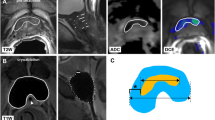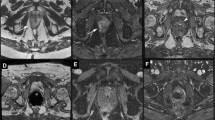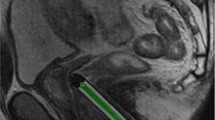Abstract
Objective
We report our initial experience and the technical feasibility of transperineal prostate cryoablation under MR guidance.
Methods
Percutaneous MR-guided cryoablation was performed in 11 patients with prostatic adenocarcinoma contraindicated for surgery (mean age: 72 years, mean Gleason score: 6.45, mean prostate-specific antigen (PSA): 6.21 ng/ml, T1-2c/N0/M0, mean: prostate volume 36.44 ml). Free-hand probe positioning was performed under real-time MR imaging. Four to seven cryoprobes were inserted into the prostate, depending on gland volume. The ice ball was monitored using real-time and high-resolution BLADE multi-planar imaging. Patients were followed at 1, 3, 6, 9 and 12 months after the procedure with serum PSA level and post-ablation MRI.
Results
Prostate cryoablation was technically feasible in 10/11 patients. The ice ball was clearly and sharply visualised in all cases as a signal-void area. Mean ice-ball volume was 53.3 ml. Mean follow-up was 15 months (range: 1–25). Mean PSA nadir was 0.33 ng/ml (range: 0.02–0.94 ng/ml). Mean hospitalisation was 5 days (range: 3–13). Complications included a urethro-rectal fistula, urinary infection, transient dysuria and scrotal pain.
Conclusions
MR-guided prostate cryoablation is feasible and promising, with excellent monitoring of the ice ball. Future perspectives could include the use of MR guidance for focal prostate cancer cryotherapy.
Key Points
• Magnetic resonance allows precise positioning of cryoprobes with real-time imaging.
• High-resolution MRI allows excellent monitoring of the developing ice ball.
• Cryoablation of prostate cancer under MR guidance is technically feasible.
• Further work will refine the procedure and make it even safer.




Similar content being viewed by others
References
Ferlay J, Autier P, Boniol M, Heanue M, Colombet M, Boyle P (2007) Estimates of the cancer incidence and mortality in Europe in 2006. Ann Oncol 18:581–592
Jemal A, Siegel R, Xu J, Ward E (2010) Cancer statistics, 2010. CA Cancer J Clin 60:277–300
Ataman F, Zurlo A, Artignan X et al (2004) Late toxicity following conventional radiotherapy for prostate cancer: analysis of the EORTC trial 22863. Eur J Cancer 40:1674–1681
Potosky AL, Legler J, Albertsen PC et al (2000) Health outcomes after prostatectomy or radiotherapy for prostate cancer: results from the Prostate Cancer Outcome Study. J Natl Cancer Inst 92:1582–1592
Heidenreich A, Bolla M, Joniau S et al (2011) Guidelines on Prostate Cancer. European Association of Urology. www.uroweb.org
Gonder MJ, Soanes WA, Shulman S (1966) Cryosurgical treatment of the prostate. Invest Urol 3:372–378
Ghafar MA, Johnson CW, De La Taille A et al (2001) Salvage cryotherapy using an argon based system for locally recurrent prostate cancer after radiation therapy: the Columbia experience. J Urol 166:1333–1337, discussion 1337–1338
Onik GM, Cohen JK, Reyes GD, Rubinsky B, Chang Z, Baust J (1993) Transrectal ultrasound-guided percutaneous radical cryosurgical ablation of the prostate. Cancer 72:1291–1299
Onik G (2007) Percutaneous image-guided prostate cancer treatment: cryoablation as a successful example. Tech Vasc Interv Radiol 10:149–158
Cohen JK, Miller RJ, Shuman BA (1995) Urethral warming catheter for use during cryoablation of the prostate. Urology 45:861–864
Zisman A, Pantuck AJ, Cohen JK, Belldegrun AS (2001) Prostate cryoablation using direct transperineal placement of ultrathin probes through a 17-gauge brachytherapy template-technique and preliminary results. Urology 58:988–993
Pisters LL, von Eschenbach AC, Scott SM et al (1997) The efficacy and complications of salvage cryotherapy of the prostate. J Urol 157:921–925
Long JP, Bahn D, Lee F, Shinohara K, Chinn DO, Macaluso JN Jr (2001) Five-year retrospective, multi-institutional pooled analysis of cancer-related outcomes after cryosurgical ablation of the prostate. Urology 57:518–523
Donnelly BJ, Saliken JC, Ernst DS et al (2002) Prospective trial of cryosurgical ablation of the prostate: five-year results. Urology 60:645–649
Han KR, Cohen JK, Miller RJ et al (2003) Treatment of organ confined prostate cancer with third generation cryosurgery: preliminary multicenter experience. J Urol 170:1126–1130
Cohen JK, Miller RJ Jr, Ahmed S, Lotz MJ, Baust J (2008) Ten-year biochemical disease control for patients with prostate cancer treated with cryosurgery as primary therapy. Urology 71:515–518
Leibovici D, Zisman A, Siegel YI, Lindner A (2001) Cryosurgical ablation for prostate cancer: preliminary results of a new advanced tecnhique. IMAJ 3:484–487
Polascik TJ, Nosnik I, Mayes JM, Mouraviev V (2007) Short-term cancer control after primary cryosurgical ablation for clinically localized prostate cancer using third-generation cryotechnology. Urology 70:117–121
Mazaheri Y, Shukla-Dave A, Hricak H et al (2008) Prostate cancer: identification with combined diffusion-weighted MR imaging and 3-D 1H spectroscopic imaging—correlation with pathologic findings. Radiology 246:480–488
Claus FG, Hricak H, Hattery RR (2004) Pretreatment evaluation of prostate cancer: role of MR imaging and 1H MR spectroscopy. Radiographics 24:S167
Franiel T, Hamm B, Hricak H (2011) Dynamic contrast-enhanced magnetic resonance imaging and pharmacokinetic models in prostate cancer. Eur Radiol 21:616–626
Heijmink SW, Futterer JJ, Strum SS et al (2011) State-of-the-art uroradiologic imaging in the diagnosis of prostate cancer. Acta Oncol 50:25–38
Silverman SG, Tuncali K, vanSonnenberg E et al (2005) Renal tumors: MR imaging-guided percutaneous cryotherapy—initial experience in 23 patients. Radiology 236:716–724
Chen X, Barkauskas KJ, Nour SG, Duerk JL, Abdul-Karim FW, Saidel GM (2007) Magnetic resonance imaging and model prediction for thermal ablation of tissue. J Magn Reson Imaging 26:123–132
Theodorescu D (2004) Cancer cryotherapy: evolution and biology. Rev Urol 6:S9–S19
Saliken JC, Donnelly BJ, Rewcastle JC (2002) The evolution and state of modern technology foe prostate cryosurgery. Urology 60:26–33
Lu A, Daniel BL, Kaye E, Butts-Pauly K (2011) MRI of frozen tissue demonstrates a phase shift. Magn Reson Med 66:1582–1589
Chin JL, Pautler SE, Mouraviev V, Touma N, Moore K, Downey DB (2001) Results of salvage cryoablation of the prostate after radiation: identifying predictors of treatment failure and complications. J Urol 165:1937–1941, discussion 1941–1932
Donnelly BJ, Saliken JC, Ernst DS et al (2005) Role of transrectal ultrasound guided salvage cryosurgery for recurrent prostate carcinoma after radiotherapy. Prostate Cancer Prostatic Dis 8:235–242
Han KR, Belldegrun AS (2004) Third-generation cryosurgery for primary and recurrent prostate cancer. BJU Int 93:14–18
Ahmed HU, Freeman A, Kirkham A et al (2011) Focal therapy for localized prostate cancer: a phase I/II trial. J Urol 185:1246–1254
Onik G, Vaughan D, Lotenfoe R, Dineen M, Brady J (2008) The "male lumpectomy": focal therapy for prostate cancer using cryoablation results in 48 patients with at least 2-year follow-up. Urol Oncol 26:500–505
de la Rosette J, Ahmed H, Barentsz J et al (2010) Focal therapy in prostate cancer—report from a consensus panel. J Endourol 24:775–780
Author information
Authors and Affiliations
Corresponding author
Rights and permissions
About this article
Cite this article
Gangi, A., Tsoumakidou, G., Abdelli, O. et al. Percutaneous MR-guided cryoablation of prostate cancer: initial experience. Eur Radiol 22, 1829–1835 (2012). https://doi.org/10.1007/s00330-012-2411-8
Received:
Revised:
Accepted:
Published:
Issue Date:
DOI: https://doi.org/10.1007/s00330-012-2411-8




